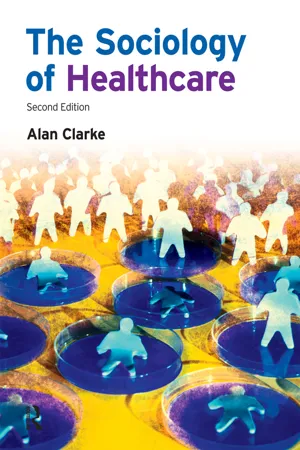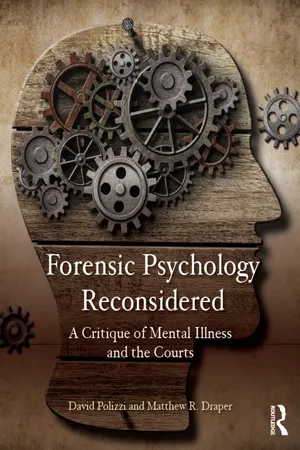Social Sciences
Mental Illness as a Social Construct
"Mental Illness as a Social Construct" refers to the idea that the concept of mental illness is shaped by social and cultural factors rather than being an objective, universal truth. It highlights how societal norms, values, and power dynamics influence the definition, diagnosis, and treatment of mental health conditions. This perspective emphasizes the need to consider social context when understanding and addressing mental illness.
Written by Perlego with AI-assistance
Related key terms
7 Key excerpts on "Mental Illness as a Social Construct"
- eBook - ePub
- Alan Clarke(Author)
- 2013(Publication Date)
- Routledge(Publisher)
Defining mental illness is no easy task. This is a field of study in which ‘terminology is a fraught and emotive issue’ (Pilgrim and Rogers, 1993, p. vii). Take, for example, the concept of ‘mental illness’, which has been described as ‘extremely elusive’ (Ineichen, 1979, p. 21) and ‘invincibly obscure’ (Gallagher, 1980, p. 19). It is a slippery concept that is open to a number of different interpretations depending upon the perspective adopted. From a lay perspective, individuals who behave in an odd or bizarre way, such as displaying a rapid change in mood from a state of deep depression to one of high elation, may be understood to be suffering from mental illness. However, although some understanding of the general concept of mental illness may be evident in lay definitions, people who act in ways that are considered to be out of the ordinary may find themselves referred to by any one of a number of derogatory terms including ‘nutcase’, ‘fruitcake’ or ‘loony’. The negative labels will vary according to the socio-cultural milieu in which the behaviour is observed and evaluated. As individuals we learn the appropriate ways of behaving in different social contexts through primary socialisation and we expect adults to perform as competent social actors. For example, while we tolerate strong emotional outbursts in childhood, such behaviour is deemed to be less appropriate in adulthood. Consequently, in this sense, ‘mental illness might be understood sociologically as failed or incomplete socialisation’ (Rogers and Pilgrim, 2005, p. 105).Expert definitions of mental illness vary both between and within the disciplines of psychiatry, clinical psychology and psychoanalysis. A description of the various approaches is beyond the scope of this chapter. The intention here is to establish the fact that mental illness is a contested concept. What the different perspectives have in common is that they attempt to identify what constitutes mental illness and speculate as to its causes. However, the nature and content of the explanations they offer is to a large extent determined by the conceptual framework adopted. In terms of the aetiology of mental illness it is possible to make a broad distinction between the biologically oriented explanations and those that are based on social or psychological factors. - eBook - ePub
- Michelle O'Reilly, Jessica Nina Lester, Michelle O'Reilly, Jessica Nina Lester(Authors)
- 2016(Publication Date)
- Palgrave Macmillan(Publisher)
Traditional understandings of medicine are thus considered to be problematic. The language associated with psychological and medical models and their disease and deficit-laden terminology arguably needs to go (Walker, 2006), with this argument being extended to our understanding of mental health and mental illness more generally. Furthermore, the four propositions outlined by Bury (1986) have important implications for the social construction of mental distress. Mental illnesses are often described in similar ways to physical ones and are also ‘treated’ with medication (Walker, 2006). In the 1960s, social constructionist work focused on mental health began in sociology and examined community and psychiatric understandings of mental illness in terms of the impact of labels (Mulvany, 2000). For mental health and mental illness, social constructionist research has tended to focus on illuminating the contingent, socially produced character of categories of mental distress and the associated professional practices (Georgaca, 2013), as well as on how biomedical classifications within psychiatry have provided the basis for society’s definitions of abnormal behaviour.Constructions of abnormality/normalityHistorically, the process of categorisation in psychiatry provided the boundaries for normality and abnormality, while also defining who is and is not eligible for services. Yet, as psychiatrist Frances (2013) noted, constructs such as ‘normal’ and ‘mental health disorder’ ‘are both extremely protean concepts – each so amorphous, heterogeneous, changeable in shape that we can never establish fixed boundaries between them’ (p. 16). Further, constructions of abnormality and normality are only made possible when comparing the object of one’s study to something else (Davis, 1995). Thus, to generate boundaries of abnormality and normality a comparative framework must be in place, wherein that which is ‘abnormal’ is only known in relation to that which is deemed ‘normal’ (Canguilhem, 1989). This benchmark of normality, however, is one that is historically, culturally, socially, and economically bound. ‘Normal’, for instance, entered the English language at a particular time in history, wherein there was a growing interest in statistics and the desire to represent the notion of a majoritarian ‘norm’. Prior to the mid-1840s, ‘norm’ referred to a carpenter’s square (Davis, 1995). Yet, over time the very concept of ‘normal’ was embedded within 18th- and 19th-century everyday practices and discourses wherein a ‘middle way’ or ‘average man’ was presumed to exist (Davis, 1995, p. 26), and he was what could be described as ‘normal’. As Davis noted: - eBook - ePub
- Sarah Nettleton(Author)
- 2020(Publication Date)
- Polity(Publisher)
We have seen how the spatialization of care and the management of patient populations have been crucial to varying constructions of ‘madness’ and ‘mental illness’. We explored how the confinement of people into institutions was key to the emergence of psychiatry professionals, who remain significant arbiters of mental health, illness and disease. But the field is not unified, and we have glimpsed some of the political theatre in which groupings of health professionals, scientists, patients, scholars and wider publics debate diagnostic labels and challenge assumptions that underpin formal health practices. Much of the debate has centred on the limitations of institutional forms, such as the lunatic asylum, the DSM, community care, the formalization of self-care and the interplay between medical and legal systems. Current concerns focus on the flexibility of diagnostic categories, not only through processes of medicalization, but also through policies of prevention and the rise of technologies designed to screen for predictive biomarkers that lie within the bodies of individuals who are not yet mentally ill, but who might be. A sociology of mental health and mental illness is therefore both critical and collective in orientation. It questions the social construction of the validity of clinical diagnoses, but, at the same time, sociologists also examine the social causation of clinical conditions to better understand how social structures, relationships and social processes can harm individual mental health. Questions and discussion points Is it possible to develop universal definitions of mental illness, mental health and mental disorders? Critically reflect on the differences between biomedical, psychological and sociological approaches to mental health and mental illness. Compare labelling theory and social causation approaches to mental illness. Further reading Busfield, J. (2011). Mental Illness. Cambridge: Polity - Constructivist approaches are easiest to accept in cases where great variation exists between cultures and societies and organic signs are lacking (as in some mental disorders, such as the example of schizophrenia in the USA and the UK). Mental illness was in fact one of the first areas where these ideas were applied, sometimes in extreme form. In the USA, Szasz was the best-known proponent of the view that the conditions psychiatrists treat did not exist in the same way as organic diseases. He claimed that in most cases it had never been demonstrated that there is a physiological abnormality in those called mentally ill, and their ‘illness’ simply consisted in behaving in ways which alarm or offend others, or in holding beliefs contrary to those usual in their society. In the UK, Eysenck suggested that the traditional field of psychiatry should be divided into a small medical part, including actual biological abnormalities or lesions, and a larger behavioural part. Another prominent name in this movement was Laing, who argued that schizophrenia, far from being a disease, was the only sane or rational way that some people have of coping with the stresses with which they are surrounded.It is generally accepted that perhaps this goes too far. Many mental illnesses do exist as biological states, and most are more than simply a reaction to a label. Still, mental illness does remain as one of the clearest examples of how diseases can obviously be constructed, as demonstrated at different times and in different cultures.
Constructivism and disability
The ideas of constructivism and ill health as ‘deviance’ have been particularly important in the field of disability and chronic illness during the last half-century. Freidson was one of the early influential writers in the USA to point out that, like other stigmatized persons, people with disabilities tend to be evaluated as a category, rather than as individuals. Indeed, two stereotypes are usually involved, both predominantly negative: the label attached to the general category of ‘disabled’ and that which describes the particular impairment (crippled, blind). Since ‘… by definition, a person said to be handicapped is so defined because he deviates from what he himself or others believed to be normal and appropriate’ (Freidson 1965: 72), then labelling, segregating and feed-back processes apply to the disabled as to other deviants. As sociologists went on to point out, there are problems about the concept of disabled people as a stigmatized minority group, and there are spokespeople for lobbies for disabled people who vigorously oppose the idea. However, in practice these processes have clearly been illustrated for a range of visible and stigmatized conditions of the sort first, historically, defined as ‘handicap’ – disfigurements, epilepsy, sense deprivation. That a state of deviance may be created by the very agencies which are supposed to identify and help was demonstrated memorably by Scott (1966), who showed the relevant welfare agencies for the blind as engaged in ‘… a socialisation process, the purpose of which is to prepare a disabled person to play a type of deviant role’ and construct blindness by ‘making blind persons out of people who cannot see’. - eBook - ePub
- Erich Goode(Author)
- 2022(Publication Date)
- Routledge(Publisher)
designated as having higher, or lower, rates of mental disorder, and what extra-psychiatric factors influence rates of institutionalization.All epidemiologists agree that measuring mental disorder in the population, or in certain segments of the population, is problematic. The issue of how mental disorder is diagnosed and determined for the purposes of an epidemiological study has filled a substantial number of very fat tomes. The rate of admissions to mental hospitals has been used as one measure or index of mental disorder in the population and categories in the population. However, we all recognize that many factors make it likelier that some persons, and persons in certain categories, will end up in a mental hospital than others, holding mental condition constant. Under certain conditions, the other persons will exacerbate someone’s mental health; under other conditions, the potentially mentally disordered person suffers in isolation. Some people live among groups and categories who hold mental hospitalization to be a viable option only under extreme circumstances; others look to institutionalization much more quickly and readily, upon signs of relatively minor abnormality or dysfunction. The point is, there is a huge non-institutionalized segment of the population who would be diagnosed as mentally disordered were they to be evaluated by a psychiatrist. Because of problems such as these, another measure of mental disorder has been developed: a diagnostic interview schedule, which, presumably, can determine mental condition in a sample of respondents. Over the years, research teams have used different interview schedules, and they have obtained somewhat different findings. Still, many experts believe that, over time, these research instruments are becoming increasingly accurate. The National Survey on Drug Use and Health (NSDUH) that cited extensively in Chapter 8 - eBook - ePub
Forensic Psychology Reconsidered
A Critique of Mental Illness and the Courts
- David Polizzi, Matthew R. Draper(Authors)
- 2015(Publication Date)
- Routledge(Publisher)
What is perhaps played out between these two images of penitentiary authority is the way the individual seems to construct these conflicting relationships. Though both are inseparably connected to the structure of institutional power, the interaction with correctional officers is perhaps experienced as being so overdetermined in its implications that resistance becomes the only recognized response. The psychotherapist, no less a function of institutional control, provides a more fluid set of possibilities offered in a far less threatening manner. Compliance with the clinical penitentiary authority is experienced in a beneficial and more respectful way that helped to deescalate the situation. It also appears as if the client experienced a much lower degree of stigma in this clinical relationship, making compliance easy to achieve. What the above discussion has attempted to demonstrate are the various ways in which the stigma of mental illness is experienced by the targeted individual. Consistent across all of these differing social contexts is the often inaccurate belief that the individual suffering from mental illness is both dangerous and unpredictable. One of the many consequences of these lingering constructions is the evolving legal image of mental illness as constructed within the law.Mental Health and the LawMental disorder among criminal defendants affects every stage of the criminal justice process, from investigational issues to competence to be executed. As in all other areas of mental health law, at least some people with mental disorders, especially severe disorders, are treated specially by the criminal law. (Morse, 2011, p. 886)Taken in its most general sense, mental health law represents the legal formulation for the meaning of mental illness as it pertains to the formal process of adjudication in American courts. Perhaps stated more specifically, mental health law in all of its various manifestations attempts to establish the legal parameters by which an individual’s behavior and level of psychological functioning is deemed sufficient to render one legally responsible for his or her actions. Central to this meaning generating the legal process is the way that mental illness is formally defined.Take for example the discussion concerning the legal formulation of mental retardation provided in Chapter One of this text. Recall that the Supreme Court, in its landmark ruling Atkins v. Virginia, 536 U.S. 304 (2002), prohibited the sentencing of individuals with mental retardation to the death penalty. However, this prohibition against such sentencing did not include a specific legal definition for this condition. Rather, the responsibility for developing the legal standard for mental retardation would be left to the states. It is therefore important to note that individual states would be under no legal obligation to adhere to the clinical or psychiatric definitions of this condition; a fact clearly witnessed in the distinction made in Texas law between the definition of mental retardation as it relates to eligibility claims for state social services and the legal definition of this type of cognitive impairment for criminal adjudications. The process by which the psychiatric condition of mental retardation has been legally constructed by the Court can be witnessed in the opinions offered in Penry v. Lynaugh (1989) and Atkins v. Virginia - eBook - ePub
- Sweetha Saji, Sathyaraj Venkatesan(Authors)
- 2021(Publication Date)
- Routledge(Publisher)
Worse still, scientific accounts of mental illness are also not productively equipped to dismantle misconceptions; instead, they concentrate on symptoms over the lived experience of the patients as individuals. As Gilman rightly comments on the negative visualisations of madness in medicine and popular art in Seeing the Insane, our understanding of the mentally ill is predicated on “the continued presence in society of older images of the insane, images that overtly or covertly color our concept and serve to categorize them upon first glance” (iii). As these mediations of madness can be copied or reproduced, their accessibility increases on a mass level and gradually leading to its legitimisation. This chapter aims to analyse how mental illness is perceived, represented, and treated in popular culture and medical discourses. In so doing, this chapter lays bare the ideologies and the symbolic codes that undergird these representations and the consequent stigma confronted by the mentally ill. Although ‘popular culture’ is interpreted as “the culture that appeals to, or that is most comprehensible by, the general public,” the term is used frequently “either to identify a form of culture that is opposed to another form, or as a synonym or complement to that other form” (Edgar and Sedgwick 190–191). As such, popular culture may refer either to “individual artefacts (often treated as texts) such as a popular song or a television programme, or to a group’s lifestyle (and thus to the pattern of artefacts, practices and understandings that serve to establish the group’s distinctive identity)” (191). Taking these cues, this chapter close-reads popular representations of mental illness in movies, newspapers, advertisements, comics, and paintings and the articulation of stereotyped images of the mentally ill in medical discourse which externalise madness in distorted physiognomic features
Learn about this page
Index pages curate the most relevant extracts from our library of academic textbooks. They’ve been created using an in-house natural language model (NLM), each adding context and meaning to key research topics.






